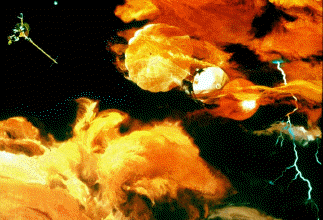This is an image of Rhea.
Click on image for full size
NASA/JPL
The Surface of Rhea
The surface of Rhea is typical of an icy moon. Rhea is as heavily cratered (despite the appearance of this picture) as Saturn's "death star" moon
Mimas on its leading side.
Its trailing side has unusual white streaks extending for many kilometers over its surface. This means Rhea was probably resurfaced at some point and has undergone active processes such as deposits of snow from fractures in the crust.
You might also be interested in:

A satellite which has an atmosphere, such as Jupiter's moon Io, or even one with an icy surface which is exposed to energetic particles, such as Saturn's moon Rhea, will leave a cloud of particles behind
...more
Titan is similar to the other icy moons, but Titan is the only icy moon to have a big atmosphere. It is natural to ask how is this possible? The nebula was colder near Saturn, than near Jupiter. The nebula
...more
Titan's atmosphere is a lot like the Earth's, except that it is very cold, from -330 degrees to -290 degrees! Like the Earth, there is a lot of Nitrogen and other complex molecules. There also may be an
...more
Pandora is a small moon of Saturn. It was discovered by S. Collins and others in 1980 from photos taken by the Voyager 1 spacecraft. Pandora's name comes from Greek mythology. Pandora was the first woman,
...more
Prometheus is a small moon of Saturn. It was discovered by S. Collins and others in 1980 from photos taken by the Voyager 1 spacecraft. This moon's name comes from Greek mythology. Prometheus was a Titan
...more
Saturn has // Call the moon count function defined in the document head print_moon_count('saturn'); moons. Many of those are tiny chunks of rock or ice only a few kilometers (miles) across. One of Saturn's
...more
Saturn has // Call the moon count function defined in the document head print_moon_count('saturn'); moons. Many of those are tiny chunks of rock or ice only a few kilometers (miles) across. One of Saturn's
...more














